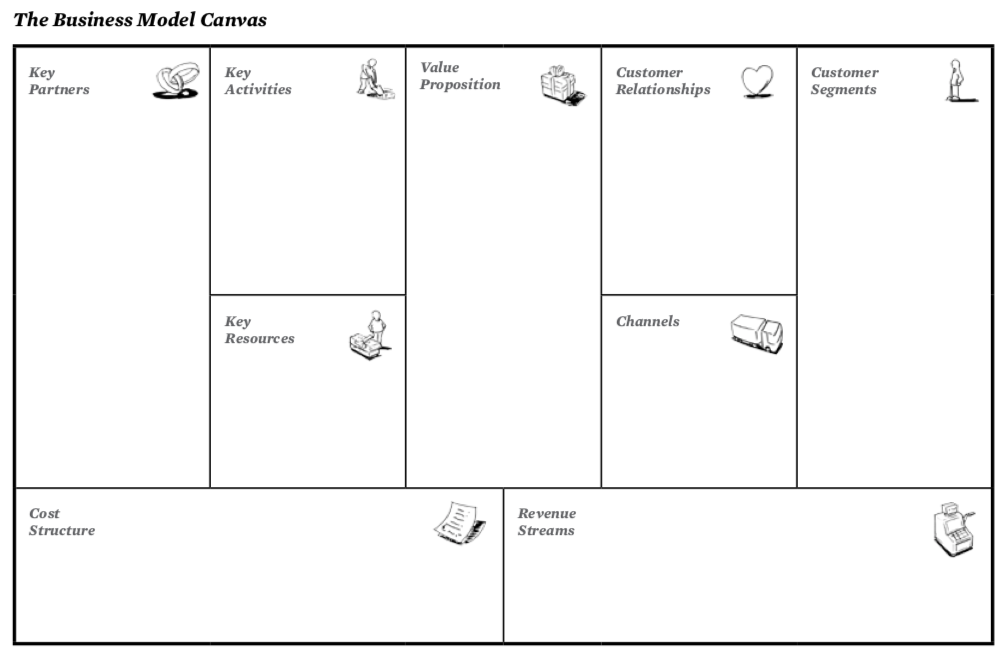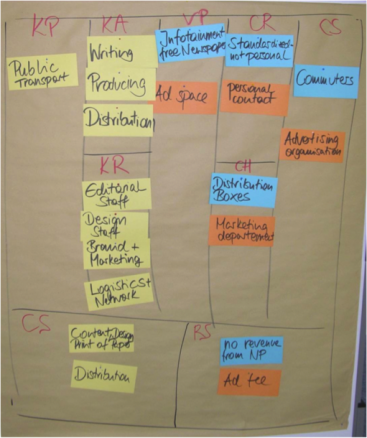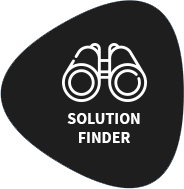A business model describes how an organisation creates, delivers, and captures value. Framing a business model within the business model canvas, consisting of nine main building blocks, helps to increase the understanding of how a business operates, and encourages discussion, creativity and analysis. This factsheet describes the main components of the business model canvas and how they can be used to increase the strength of your business model.
A business model describes the rationale of how an organisation creates, delivers, and captures value. The business model canvas is a tool that can be used to translate a business model into nine building blocks that show the logic of how a company intends to make money. The main purpose of a business model canvas is to foster understanding, encourage discussion, creativity and analysis.
There are nine main building blocks in a business model canvas:

The business model canvas. Source: OSTERWALDER & PIGNEUR 2009
Defines the different groups of people or organisations an enterprise aims to reach and serve. The Customer Segments can be broken down into sub-segments if their needs require and justify a distinct offer (e.g. they are reached through different channels, they require different types of relationships, they have substantially different profitabilities, or they are willing to pay for different aspects of the offer).
The Value Propositions represent the bundle of products and services that create value for a specific Customer Segment. The Value Propositions may be quantitative (e.g. price, speed of service) or qualitative (e.g. design, customer experience).
Channels describe how a company communicates with and reaches its Customer Segments to deliver their Value Proposition. Channels represent a company’s interface with its customers, and can include communication, distribution, and sales.
Customer Relationships describe the types of relationships a company establishes with specific Customer Segments, and can range from personal relationships to entirely automated interactions. The Customer Relationships are a key issue in determining the overall customer experience.
The Revenue Stream describes how a company will generate cash from each Customer Segment. The Revenue Stream has to take into account how much customers will be willing to pay for the value the company delivers. There are two basic types of revenue stream: revenues from one-time customer payments, and recurring revenues from on-going payments.
The Key Resources describes the most important assets within a company that make a business model work. Thesegenerally include physical resources (e.g. buildings, vehicles, etc.), intellectual resources (e.g. brands, partnerships, proprietary knowledge, etc.), human resources (e.g. employees), and financial resources (e.g. cash, lines of credit, etc.)
The Key Activities describe the most important things a company must do to make its business model work. They can be activities to create and offer Value Propositions, reach markets, maintain Customer Relationships, and earn revenues. General categories for Key Activities include production, problem solving, and platform/networking.
The Key Partnerships describes the network of suppliers and partners that make a business model work. Partnerships are essential in most businesses to optimise their business models, reduce risk, or acquire resources. Partnerships can generally be categorised into: strategic alliances between non-competitors, strategic partnership between competitors, joint ventures to develop new businesses, and buyer-supplier relationships.

Example of a business model canvas for the free Swiss newspaper, 20 Minutes. Source: CEWAS (2012)
The Cost Structure describes all costs incurred to operate a business model, for example in creating and delivering value, maintaining Customer Relationships, and generating revenue. Cost structures can be divided into fixed costs, variable costs, economies of scale, and economies of scope.
- Draw the business model canvas on a large sheet of brown paper. Usedifferent coloured cards to fill in the building blocks of the canvas.
- Start with the different Value Propositions your company offers, and for whichCustomer Segments these Value Propositions are offered. The colour you use for the Value Propositions should correspond to their respective Customer Segments.
- Once Value Propositions and Customer Segments are filled in, complete the elements of the business model canvas. Coordinate using coloured cards when it makes sense. For example, the above business model canvas uses blue and orange to distinguish between two distinct Customer Segments that have clearly differentValue Propositions, Customer Relationships, Channels, and Revenue Streams.
- Once complete, the business model template is a useful tool for understanding and analysing a business model in order to:
- Demonstrate how it makes financial sense.
- Visualise the roles and interdependencies of members of an organisation.
- Think holistically about all components of the business model.
- Establish a common language and framework with colleagues.
- Clarify aspects of current business models.
- Provide a reality check for the feasibility of new start-ups.
- Start to formulate a business plan to bring your idea into a reality.
Business Model Generation
Business Model Generation in Sustainable Sanitation & Water Management
This PowerPoint explains the concept of a business model and how it is critical for the success of a business, particularly in the field of sustainable sanitation & water management.
KROPAC, M. (2013): Business Model Generation in Sustainable Sanitation & Water Management. Willisau: cewas – the international centre for water management serviceshttp://www.businessmodelgeneration.com/
As the official website of Business Model Generation by Osterwalder & Pigneur, this website offers guidance and resources for making use of the business model template.
http://www.businessmodelgeneration.com/
Download a pdf of the business model canvas from Business Model Generation by Osterwalder & Pigneur here.
http://bmimatters.com/
This blog entry from BMI Matters takes readers step by step through understanding the business models of well-known companies like LinkedIn and Google by fitting them within the business model template.
cewas - The business and integrity experts in the water sector
cewas is a Swiss-based international centre of competence in the field of sustainable sanitation and water resource management. It combines advanced education with a start-up centre, a think tank, and a business platform.



